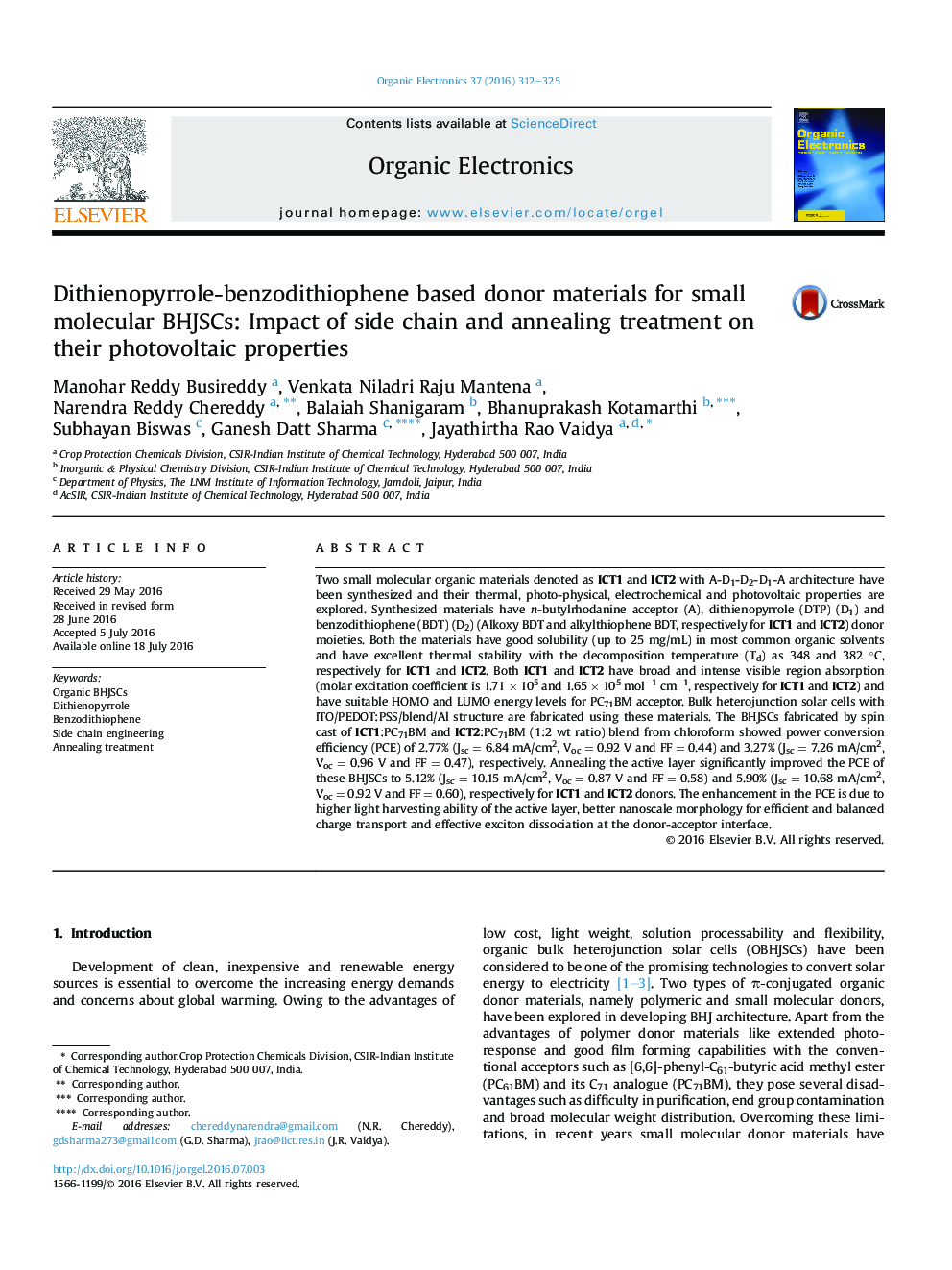| کد مقاله | کد نشریه | سال انتشار | مقاله انگلیسی | نسخه تمام متن |
|---|---|---|---|---|
| 1264690 | 1496820 | 2016 | 14 صفحه PDF | دانلود رایگان |

• Two small molecular donor materials ICT1 and ICT2 have been developed for BHJSCs.
• Thermal, optoelectronic and photovoltaic properties of ICT1 and ICT2 are explored.
• BHJSCs with PC71BM acceptor showed PCE of 5.12% and 5.90% for ICT1 and ICT2.
• Impact of side chain and TSA of active layer is investigated using XRD and AFM.
• Moreover, this is the first report on BDT-DTP based donor materials for SMBHJSCs.
Two small molecular organic materials denoted as ICT1 and ICT2 with A-D1-D2-D1-A architecture have been synthesized and their thermal, photo-physical, electrochemical and photovoltaic properties are explored. Synthesized materials have n-butylrhodanine acceptor (A), dithienopyrrole (DTP) (D1) and benzodithiophene (BDT) (D2) (Alkoxy BDT and alkylthiophene BDT, respectively for ICT1 and ICT2) donor moieties. Both the materials have good solubility (up to 25 mg/mL) in most common organic solvents and have excellent thermal stability with the decomposition temperature (Td) as 348 and 382 °C, respectively for ICT1 and ICT2. Both ICT1 and ICT2 have broad and intense visible region absorption (molar excitation coefficient is 1.71 × 105 and 1.65 × 105 mol−1 cm−1, respectively for ICT1 and ICT2) and have suitable HOMO and LUMO energy levels for PC71BM acceptor. Bulk heterojunction solar cells with ITO/PEDOT:PSS/blend/Al structure are fabricated using these materials. The BHJSCs fabricated by spin cast of ICT1:PC71BM and ICT2:PC71BM (1:2 wt ratio) blend from chloroform showed power conversion efficiency (PCE) of 2.77% (Jsc = 6.84 mA/cm2, Voc = 0.92 V and FF = 0.44) and 3.27% (Jsc = 7.26 mA/cm2, Voc = 0.96 V and FF = 0.47), respectively. Annealing the active layer significantly improved the PCE of these BHJSCs to 5.12% (Jsc = 10.15 mA/cm2, Voc = 0.87 V and FF = 0.58) and 5.90% (Jsc = 10.68 mA/cm2, Voc = 0.92 V and FF = 0.60), respectively for ICT1 and ICT2 donors. The enhancement in the PCE is due to higher light harvesting ability of the active layer, better nanoscale morphology for efficient and balanced charge transport and effective exciton dissociation at the donor-acceptor interface.
Two small molecular donor materials ICT1 and ICT2 with A-D1-D2-D1-A architecture have been synthesized and their thermal, photo-physical, electrochemical and photovoltaic properties are explored. Side chain engineering and annealing treatment of the active layer substantially improved the PCEs of the BHJSCs based on these donor materials. Best over all PCE of 5.90% (Jsc = 10.68 mA/cm2, Voc = 0.92 V and FF = 0.60) is achieved for the devices with ICT2:PC71BM active layer.Figure optionsDownload as PowerPoint slide
Journal: Organic Electronics - Volume 37, October 2016, Pages 312–325